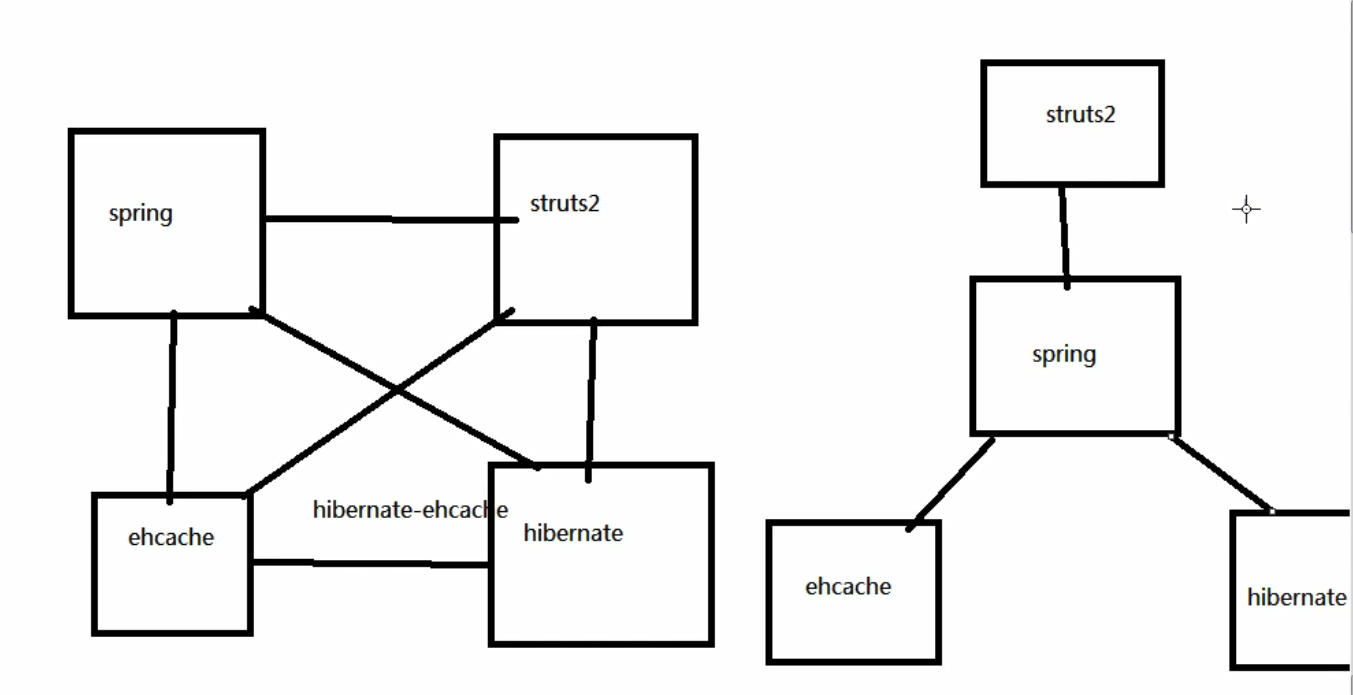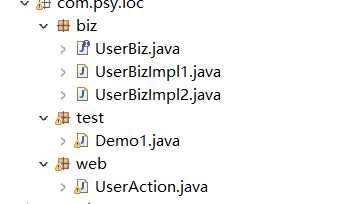什么是spring,它能够做什么?
Spring是一个开源框架,它由Rod Johnson创建。它是为了解决企业应用开发的复杂性而创建的。
Spring使用基本的JavaBean来完成以前只可能由EJB完成的事情。
然而,Spring的用途不仅限于服务器端的开发。从简单性、可测试性和松耦合的角度而言,任何Java应用都可以从Spring中受益。
目的:解决企业应用开发的复杂性
功能:使用基本的JavaBean代替EJB,并提供了更多的企业应用功能
范围:任何Java应用
简单来说,Spring是一个轻量级的控制反转(IoC)和面向切面(AOP)的容器框架。
用一张图来了解Spring

Spring在这里相当于一个万能胶的作用 就是让对象与对象(模块与模块)之间的关系没有通过代码来关联,都是通过配置类说明
管理的(Spring根据这些配置 内部通过反射去动态的组装对象)
什么是控制反转(或依赖注入)
控制反转(IoC=Inversion of Control)IoC,用白话来讲,就是由容器控制程序之间的(依赖)关系,而非传统实现中,由程序代码直接操控。这也就是所谓“控制反转”的概念所在:(依赖)控制权由应用代码中转到了外部容器,控制权的转移,是所谓反转。
IoC还有一个另外的名字:“依赖注入 (DI=Dependency Injection)” ,即由容器动态的将某种依赖关系注入到组件之中
案例:实现Spring的IoC
IOC/DI
将以前由程序员实例化对象/赋值的工作交给了spring处理
spring管理bean的方式
* set注入
* 基本数据类型
* 引用数据类型
* 构造注入
* 自动装配
用代码来了解一下set注入(基本数据类型)
pom.xml
<project xmlns="http://maven.apache.org/POM/4.0.0" xmlns:xsi="http://www.w3.org/2001/XMLSchema-instance" xsi:schemaLocation="http://maven.apache.org/POM/4.0.0 http://maven.apache.org/maven-v4_0_0.xsd"> <modelVersion>4.0.0</modelVersion> <groupId>com.psy</groupId> <artifactId>spring</artifactId> <packaging>war</packaging> <version>0.0.1-SNAPSHOT</version> <name>spring Maven Webapp</name> <url>http://maven.apache.org</url> <properties> <spring.version>5.0.1.RELEASE</spring.version> <javax.servlet.version>4.0.0</javax.servlet.version> <junit.version>4.12</junit.version> </properties> <dependencies> <dependency> <groupId>junit</groupId> <artifactId>junit</artifactId> <version>3.8.1</version> <scope>test</scope> </dependency> <!-- 2、导入spring依赖 --> <dependency> <groupId>org.springframework</groupId> <artifactId>spring-context</artifactId> <version>${spring.version}</version> </dependency> <dependency> <groupId>org.springframework</groupId> <artifactId>spring-aspects</artifactId> <version>${spring.version}</version> </dependency> <!-- 5.1、junit --> <dependency> <groupId>junit</groupId> <artifactId>junit</artifactId> <version>${junit.version}</version> <scope>test</scope> </dependency> <!-- 5.2、servlet --> <dependency> <groupId>javax.servlet</groupId> <artifactId>javax.servlet-api</artifactId> <version>${javax.servlet.version}</version> <scope>provided</scope> </dependency> </dependencies> <build> <finalName>T224_spring</finalName> <plugins> <plugin> <groupId>org.apache.maven.plugins</groupId> <artifactId>maven-compiler-plugin</artifactId> <version>3.7.0</version> <configuration> <source>1.8</source> <target>1.8</target> <encoding>UTF-8</encoding> </configuration> </plugin> </plugins> </build> </project>
web.xml
<web-app xmlns="http://xmlns.jcp.org/xml/ns/javaee" xmlns:xsi="http://www.w3.org/2001/XMLSchema-instance" xsi:schemaLocation="http://xmlns.jcp.org/xml/ns/javaee http://xmlns.jcp.org/xml/ns/javaee/web-app_3_1.xsd" version="3.1"> <display-name>Archetype Created Web Application</display-name> </web-app>
Spring-context.xml
<?xml version="1.0" encoding="UTF-8"?> <beans xmlns="http://www.springframework.org/schema/beans" xmlns:xsi="http://www.w3.org/2001/XMLSchema-instance" xmlns:aop="http://www.springframework.org/schema/aop" xmlns:context="http://www.springframework.org/schema/context" xsi:schemaLocation="http://www.springframework.org/schema/beans http://www.springframework.org/schema/beans/spring-beans.xsd http://www.springframework.org/schema/aop http://www.springframework.org/schema/aop/spring-aop-4.3.xsd http://www.springframework.org/schema/context http://www.springframework.org/schema/context/spring-context-4.3.xsd"> <bean id="userAction" class="com.psy.ioc.web.UserAction"> <property name="uid" value="22"></property> <property name="uname" value="zs"></property> <property name="hobby"> <list> <value>rap</value> <value>rap2</value> </list> </property> </bean> </beans>
写一个接口两个实现类
web层以及测试类

UserAction
package com.psy.ioc.web; import java.util.ArrayList; import java.util.List; import com.psy.ioc.biz.UserBiz; import com.psy.ioc.biz.UserBizImpl1; import com.psy.ioc.biz.UserBizImpl2; /** * 弊端: * 当需求变化非常快的时候 不便于维护。因为维护的权利是属于程序员的 * * spring的IOC就是解决这一问题的 * 将维护代码的权利由程序员转交给spring容器来完成 * * * 1.spring管理bean的方式 * set注入 * 基本数据类型 * 引用数据类型 * 构造注入 * 自动装配 * * @author Admin * */ public class UserAction { private UserBiz userBiz = new UserBizImpl2(); private int uid; private String uname; private List<String> hobby = new ArrayList<String>(); public int getUid() { return uid; } public void setUid(int uid) { this.uid = uid; } public String getUname() { return uname; } public void setUname(String uname) { this.uname = uname; } public List<String> getHobby() { return hobby; } public void setHobby(List<String> hobby) { this.hobby = hobby; } public UserAction() { super(); // TODO Auto-generated constructor stub } public UserAction(int uid, String uname) { super(); this.uid = uid; this.uname = uname; } /** * set注入 */ public void test1() { System.out.println("uid" + this.uid); System.out.println("uname" + this.uname); System.out.println("hobby" + this.hobby); } /** * 构造注入 */ public void test2() { } public void test3() { userBiz.read(); } }
测试类:
/** * 模拟浏览器请求 请求后台 * @author Admin * */ public class Demo1 { public static void main(String[] args) throws Exception{ UserAction userAction=new UserAction(); userAction.test1(); } }
打印结果就是我们在Spring-context.xml定义的值
set注入(引用数据类型)
定义private UserBiz userBiz; 并且提供setget方法
Spring-context.xml中
<bean id="userBiz" class="com.psy.ioc.biz.UserBizImpl2"></bean>
<property name="userBiz" ref="userBiz"></property>
构造注入同理
我们将set方法注释,加入构造函数
同时Spring-context.xml改成
<constructor-arg name="uid" value="22"></constructor-arg> <constructor-arg name="uname" value="zs"></constructor-arg>
测试方法:
/** * 模拟浏览器请求 请求后台 * @author Admin * */ public class Demo1 { public static void main(String[] args) throws Exception{ // UserAction userAction=new UserAction(); // userAction.test1(); ApplicationContext context= new ClassPathXmlApplicationContext("/spring-context.xml"); UserAction bean = (UserAction) context.getBean("userAction"); bean.test1(); } }
自动装配:
在Spring-context.xml中加入这样一行
default-autowire="byType"
注释掉<!-- <property name="userBiz" ref="userBiz"></property> -->也能达到想要的效果
当然这样的前提是spring的上下文只管理一个
如果我们想要管理多个
<bean id="userBiz" class="com.psy.ioc.biz.UserBizImpl1"></bean> <bean id="userBiz2" class="com.psy.ioc.biz.UserBizImpl2"></bean>
将“byType”改成“ByName”
default-autowire="byName"
tomcat管理spring
如何将spring的上下文交给tomcat上下文进行管理
首先spring上下文为什么Tomact?
分析:目前工程中的所有javabean都交给了spring进行管理,那么浏览器
发送请求,请求的是tomcat,由tomcat来处理请求,tomcat处理请求一般来说都要访问数据库
数据库是由Dao层访问的,Dao层的实体类有事交给spring的上下文管理
那就意味着,tomcat要处理请求,必须拿到spring的上下文,才能够
拿到Dao层的Javabean
SpringLoadListener类:
/ @WebListener public class SpringLoadListener implements ServletContextListener { private String springXmlLocation=""; @Override public void contextInitialized(ServletContextEvent sce) { System.out.println("监听了tomcat的启动。。。。。"); ServletContext servletContext =sce.getServletContext(); springXmlLocation= servletContext.getInitParameter("springXmlLocation"); if(null ==springXmlLocation|| "".equals(springXmlLocation)) { springXmlLocation="/spring_context.xml"; } System.out.println("springXmlLocation:"+springXmlLocation); ApplicationContext springContext=new ClassPathXmlApplicationContext(springXmlLocation); servletContext.setAttribute("SPRING_CONTEXT_KEY", springContext); } }
UserServlet类:
@WebServlet("/user") public class UserServlet extends HttpServlet { /** * */ private static final long serialVersionUID = -4749851066001594899L; @Override protected void doGet(HttpServletRequest req, HttpServletResponse resp) throws ServletException, IOException { doPost(req, resp); } @Override protected void doPost(HttpServletRequest req, HttpServletResponse resp) throws ServletException, IOException { ServletContext servletContext=req.getServletContext(); ApplicationContext springContext=(ApplicationContext) servletContext.getAttribute("SPRING_CONTEXT_KEY"); UserAction bean=(UserAction) springContext.getBean("userAction"); bean.test3(); } }
web.xml:
<web-app xmlns:xsi="http://www.w3.org/2001/XMLSchema-instance" xmlns="http://java.sun.com/xml/ns/javaee" xsi:schemaLocation="http://java.sun.com/xml/ns/javaee http://java.sun.com/xml/ns/javaee/web-app_3_1.xsd" id="WebApp_ID" version="3.1"> <display-name>Archetype Created Web Application</display-name> <context-param> <param-name>springXmlLocation</param-name> <param-value>/spring_context.xml</param-value> </context-param> </web-app>